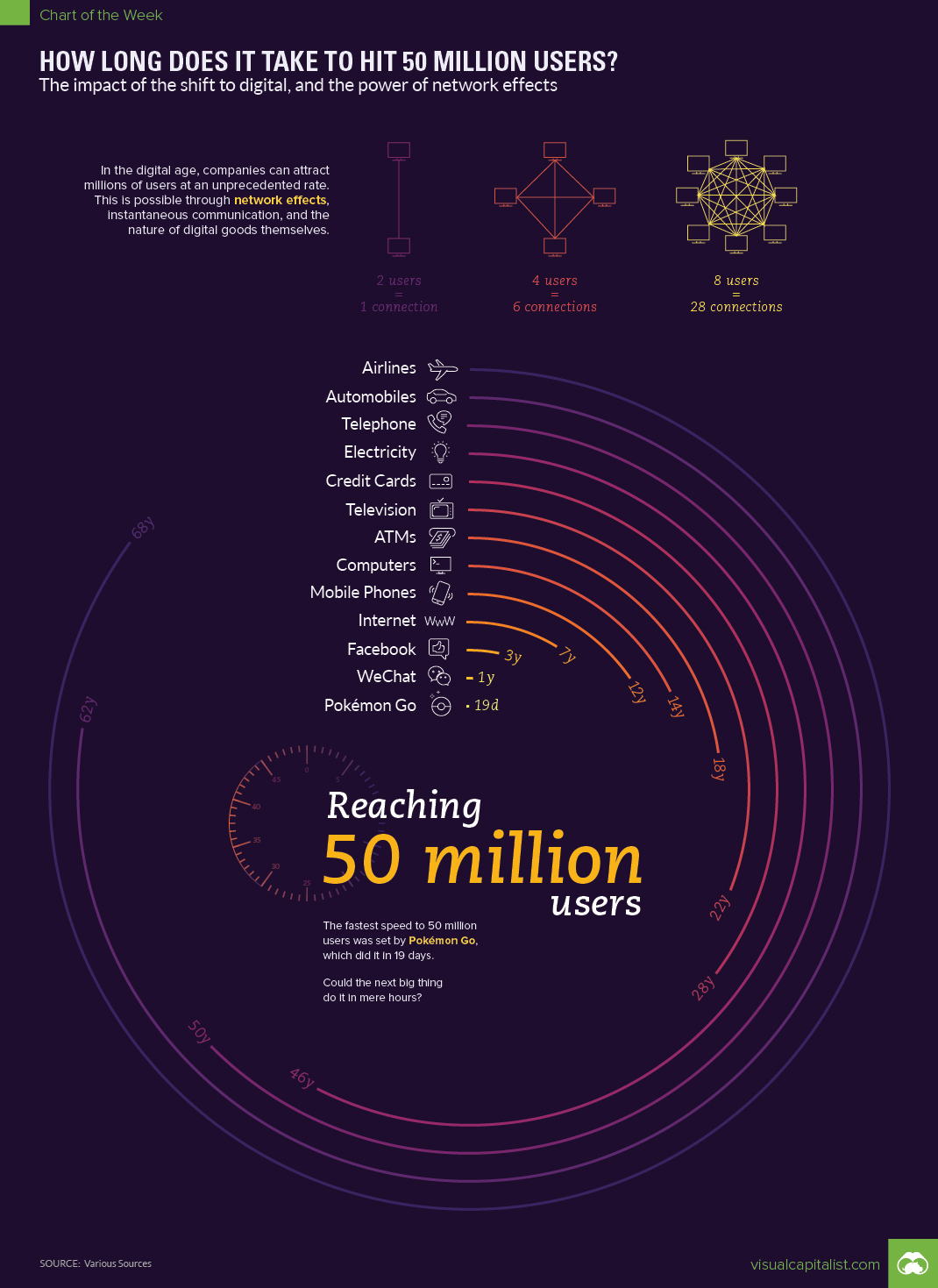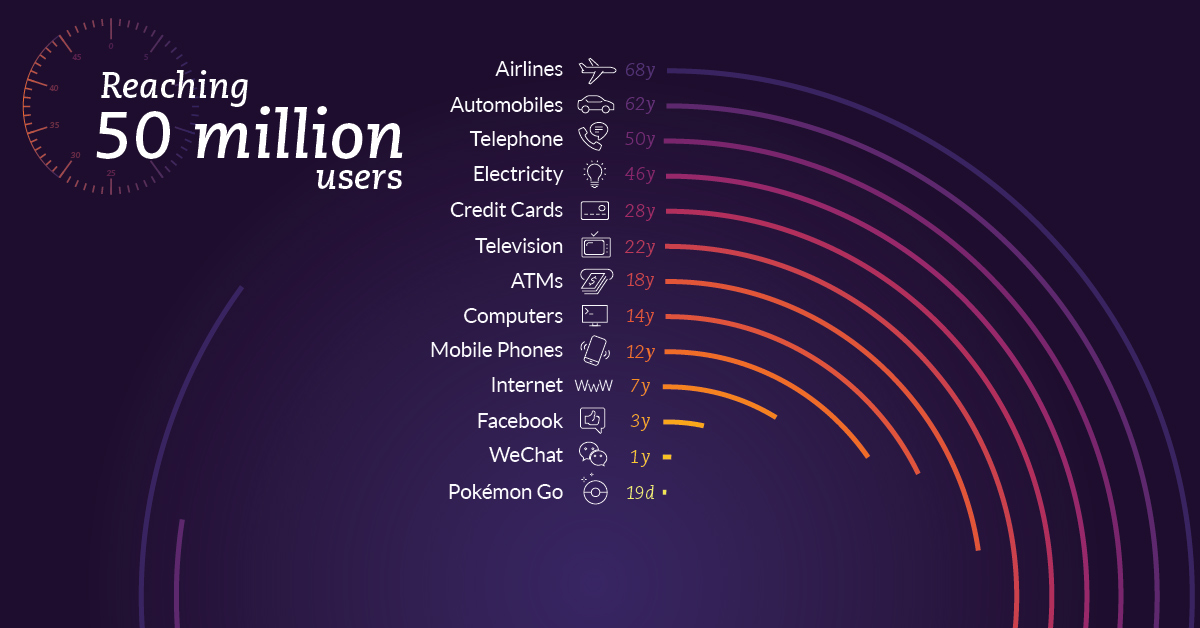Technology
How Long Does It Take to Hit 50 Million Users?

How Long Does It Take to Hit 50 Million Users?
The Chart of the Week is a weekly Visual Capitalist feature on Fridays.
Imagine it’s the year 1960, and you’re an entrepreneur that’s about to launch the next big thing.
Let’s assume that your product is actually pretty revolutionary, and that you’re going to receive widespread buzz and word-of-mouth traction. How quickly do you think it could be adopted by millions of users?
Before the internet and consumption of digital goods, the use of a product could only spread as fast as you could manufacture the physical good. You would first need many millions of dollars in capital, a plant, a workforce, and inventory. Then, once the product is ready for distribution, you’d need mass advertising, word-of-mouth, sales channels, and press coverage to stand a chance.
Even then, if the product is really revolutionary, you’re looking at a decade or more for it to get widespread adoption.
Atoms Versus Bytes
Automobiles took 62 years to be adopted by 50 million users. The telephone took three years just to be in the homes of 50,000 people.
But these are both physical goods that need raw materials, skilled workers to produce, and economies of scale. They are made of atoms – and atoms must abide by the laws of physics.
In the modern era, you don’t have to produce a physical good. All you need to do is produce a useful piece of code that be replicated or re-used indefinitely at a marginal cost near zero, and it can spread like a wildfire.
| Product / Technology | Time it Took to Hit 50 Million Users |
|---|---|
| Airlines | 64 years |
| Automobiles | 62 years |
| Telephone | 50 years |
| Electricity | 46 years |
| Credit Cards | 28 years |
| Television | 22 years |
| ATMs | 18 years |
| Computers | 14 years |
| Mobile Phones | 12 years |
| Internet | 7 years |
| 4 years | |
| 1 year | |
| Pokemon Go | 19 days |
As you can see, the transition from physical to digital goods has affected adoption rates, but so has the growing power of network effects.
Metcalfe’s Law
Metcalfe’s Law states the effect of a network is proportional to the square of the number of connected users of the system (n2).
Within the context above, it simply means that each additional user of a good or service adds additional value to others in that network. New goods or services in the digital realm can harness this network effect to gain users at unprecedented rates. It’s why social media, apps, and the internet were able to take off so quick.
It’s also why the augmented reality game Pokémon Go was able to reach a mind-blowing 50 million users in just 19 days.
And now, with unparalleled connectivity and more than four billion internet users globally, the next big thing could hit that milestone even faster than Pokémon Go. Instead of almost three weeks, it might do so in a few days – or even a few hours.
Technology
Visualizing AI Patents by Country
See which countries have been granted the most AI patents each year, from 2012 to 2022.

Visualizing AI Patents by Country
This was originally posted on our Voronoi app. Download the app for free on iOS or Android and discover incredible data-driven charts from a variety of trusted sources.
This infographic shows the number of AI-related patents granted each year from 2010 to 2022 (latest data available). These figures come from the Center for Security and Emerging Technology (CSET), accessed via Stanford University’s 2024 AI Index Report.
From this data, we can see that China first overtook the U.S. in 2013. Since then, the country has seen enormous growth in the number of AI patents granted each year.
| Year | China | EU and UK | U.S. | RoW | Global Total |
|---|---|---|---|---|---|
| 2010 | 307 | 137 | 984 | 571 | 1,999 |
| 2011 | 516 | 129 | 980 | 581 | 2,206 |
| 2012 | 926 | 112 | 950 | 660 | 2,648 |
| 2013 | 1,035 | 91 | 970 | 627 | 2,723 |
| 2014 | 1,278 | 97 | 1,078 | 667 | 3,120 |
| 2015 | 1,721 | 110 | 1,135 | 539 | 3,505 |
| 2016 | 1,621 | 128 | 1,298 | 714 | 3,761 |
| 2017 | 2,428 | 144 | 1,489 | 1,075 | 5,136 |
| 2018 | 4,741 | 155 | 1,674 | 1,574 | 8,144 |
| 2019 | 9,530 | 322 | 3,211 | 2,720 | 15,783 |
| 2020 | 13,071 | 406 | 5,441 | 4,455 | 23,373 |
| 2021 | 21,907 | 623 | 8,219 | 7,519 | 38,268 |
| 2022 | 35,315 | 1,173 | 12,077 | 13,699 | 62,264 |
In 2022, China was granted more patents than every other country combined.
While this suggests that the country is very active in researching the field of artificial intelligence, it doesn’t necessarily mean that China is the farthest in terms of capability.
Key Facts About AI Patents
According to CSET, AI patents relate to mathematical relationships and algorithms, which are considered abstract ideas under patent law. They can also have different meaning, depending on where they are filed.
In the U.S., AI patenting is concentrated amongst large companies including IBM, Microsoft, and Google. On the other hand, AI patenting in China is more distributed across government organizations, universities, and tech firms (e.g. Tencent).
In terms of focus area, China’s patents are typically related to computer vision, a field of AI that enables computers and systems to interpret visual data and inputs. Meanwhile America’s efforts are more evenly distributed across research fields.
Learn More About AI From Visual Capitalist
If you want to see more data visualizations on artificial intelligence, check out this graphic that shows which job departments will be impacted by AI the most.
-

 Markets1 week ago
Markets1 week agoU.S. Debt Interest Payments Reach $1 Trillion
-

 Markets2 weeks ago
Markets2 weeks agoRanked: The Most Valuable Housing Markets in America
-

 Money2 weeks ago
Money2 weeks agoWhich States Have the Highest Minimum Wage in America?
-

 AI2 weeks ago
AI2 weeks agoRanked: Semiconductor Companies by Industry Revenue Share
-

 Markets2 weeks ago
Markets2 weeks agoRanked: The World’s Top Flight Routes, by Revenue
-

 Countries2 weeks ago
Countries2 weeks agoPopulation Projections: The World’s 6 Largest Countries in 2075
-

 Markets2 weeks ago
Markets2 weeks agoThe Top 10 States by Real GDP Growth in 2023
-

 Money2 weeks ago
Money2 weeks agoThe Smallest Gender Wage Gaps in OECD Countries















